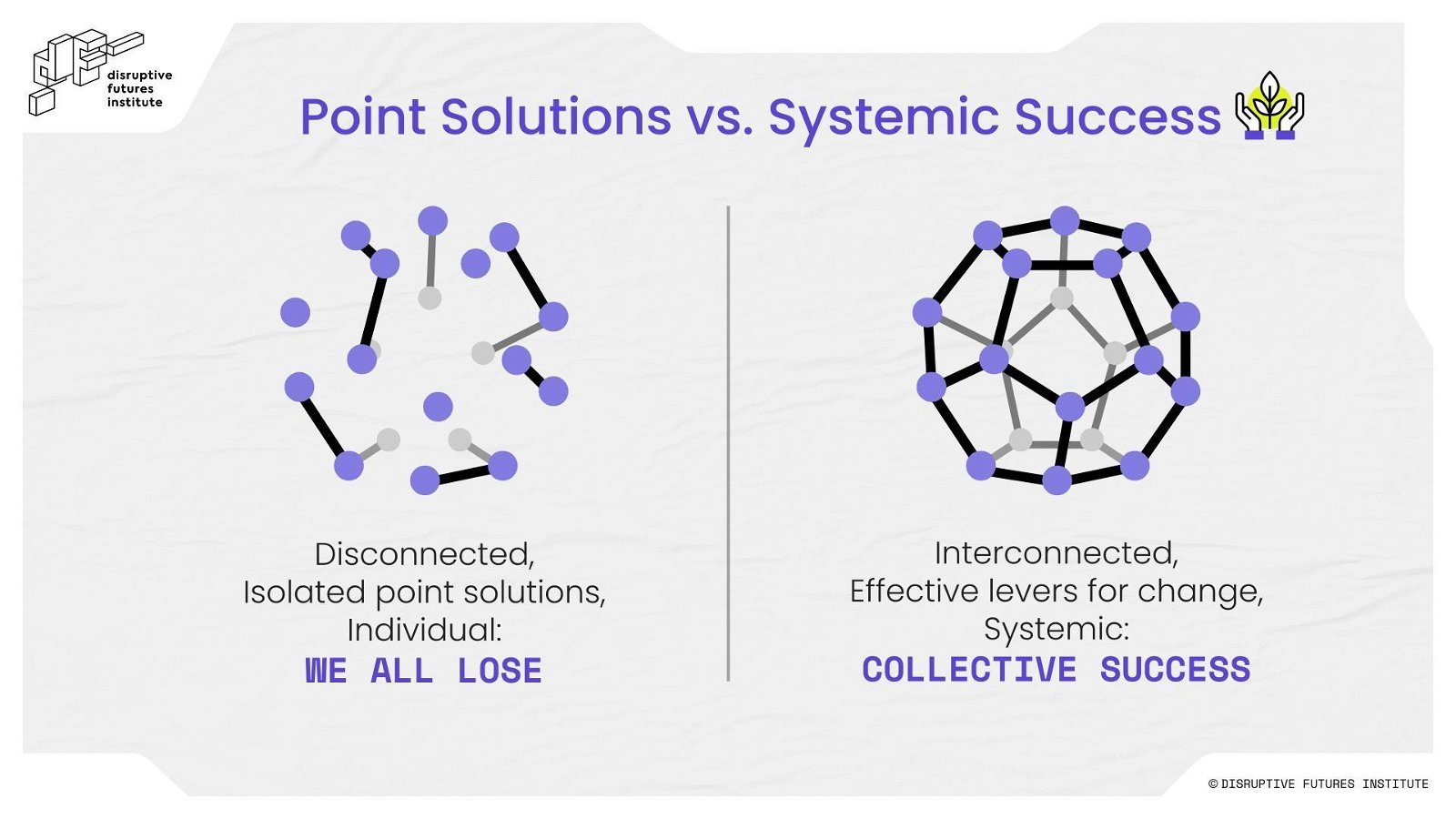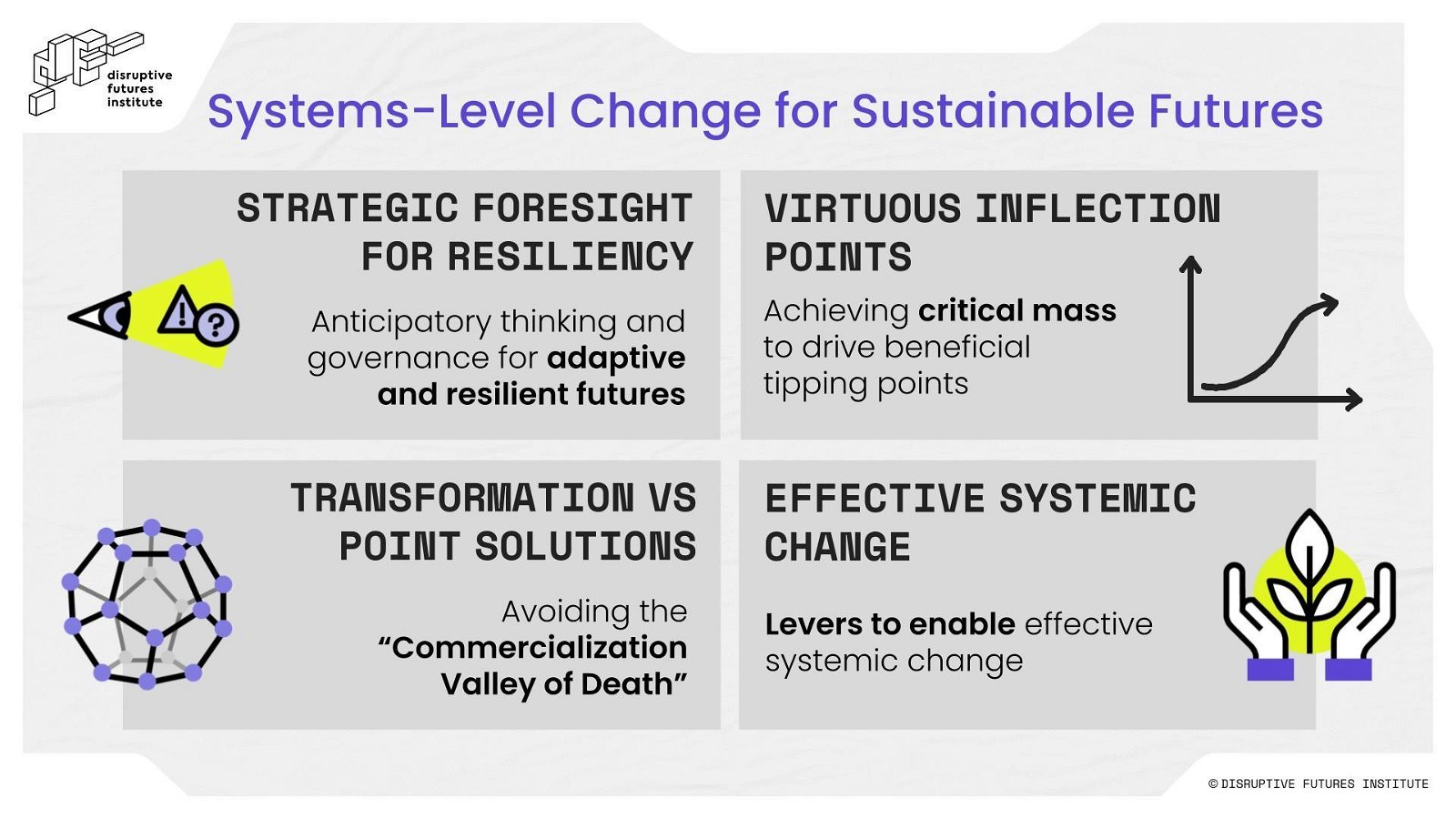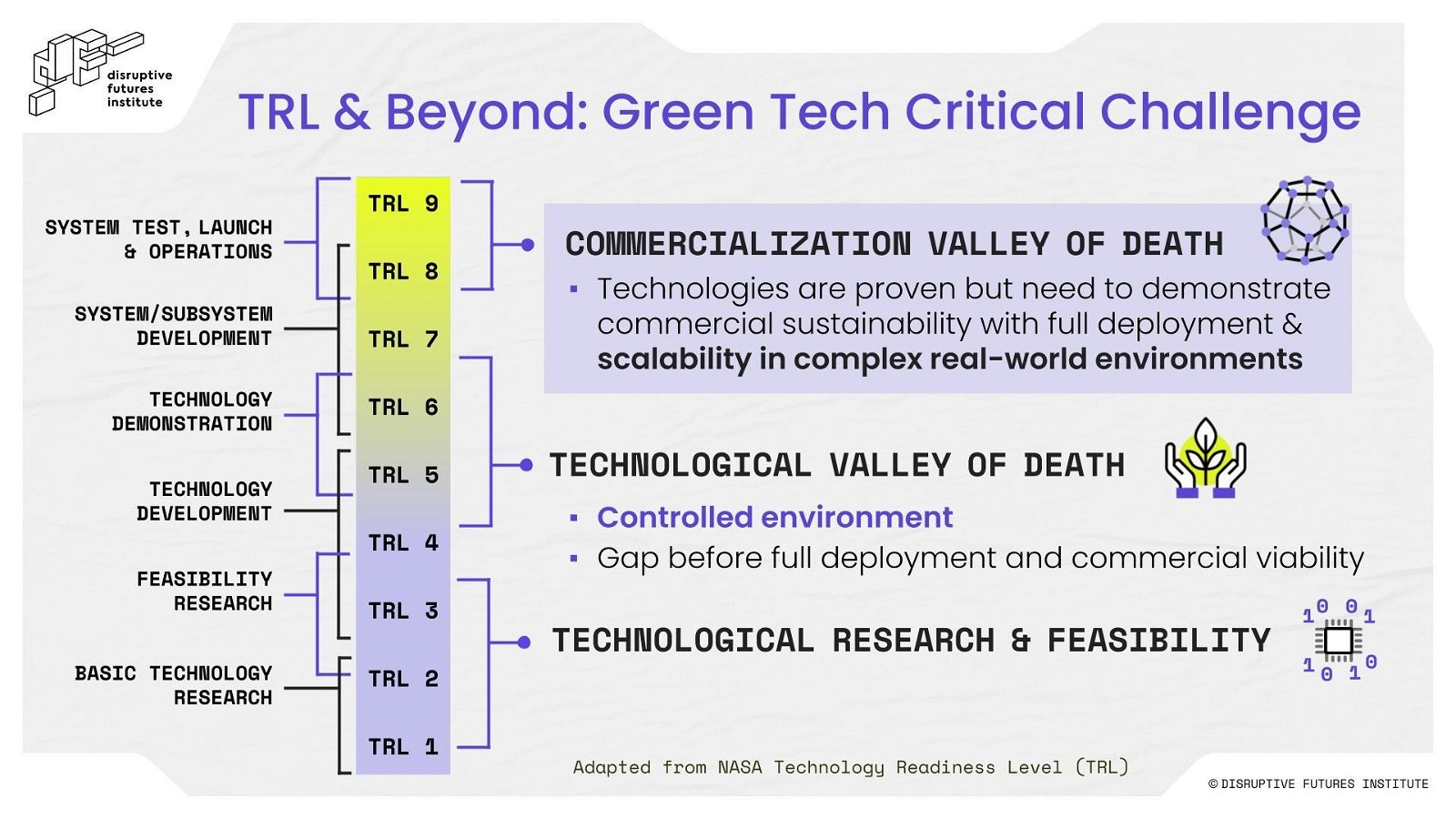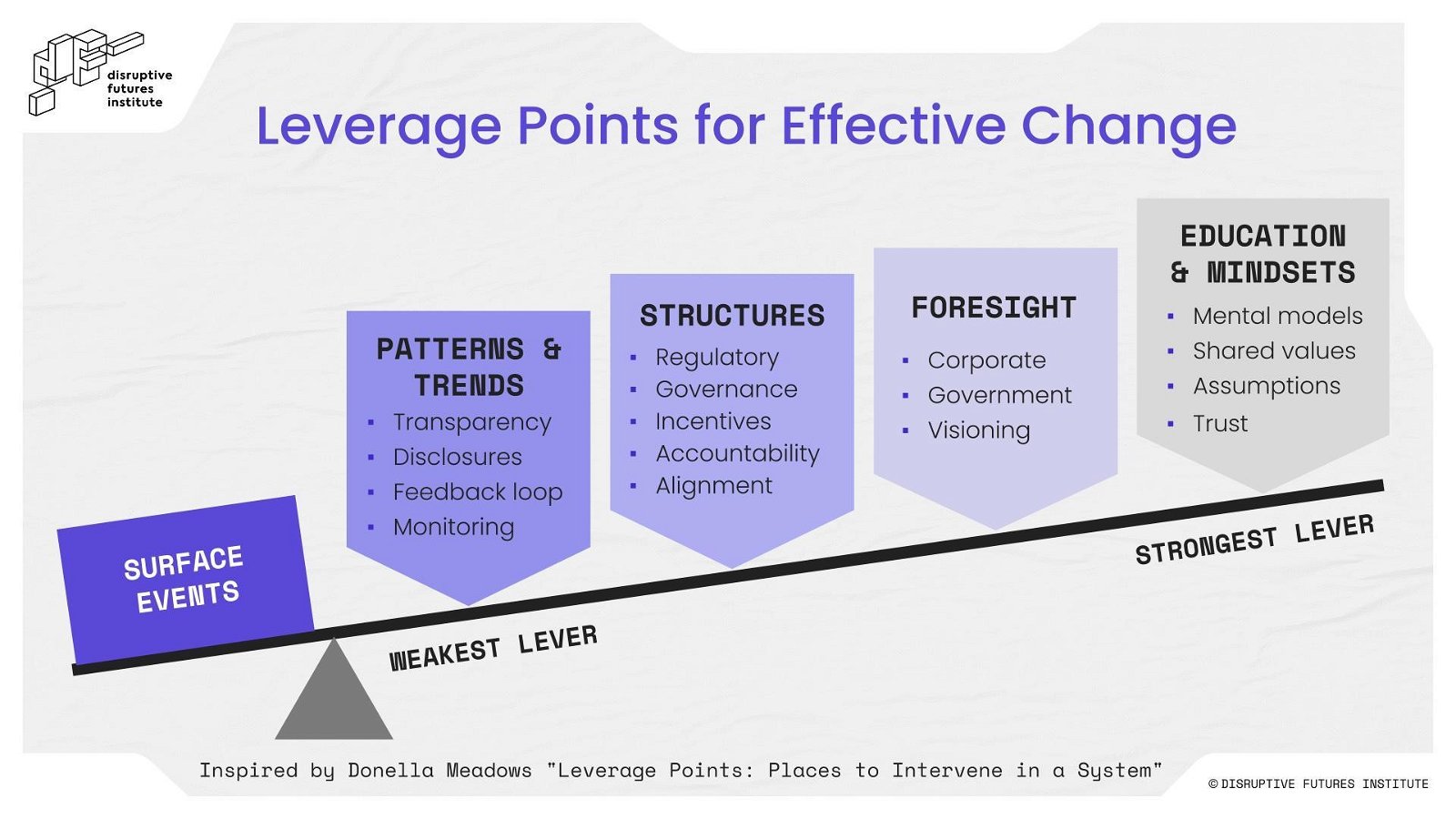· 6 min read
The world’s most critical challenges are complex covering the climate, society and emerging technologies. Addressing these requires systemic change, not isolated solutions. To achieve systemic change, organizations must consider a broad set of stakeholders, partners and complex ecosystem interactions. If solutions aren’t systemic, we all lose.

Achieving sustainable futures requires humanity to solve our most complex, systemic and existential risks. This demands a deeper understanding of systems-level change - deeper than discrete surface-level point solutions.
Drawing on futures' studies, there are four related mindsets and actions that can lead to systems-level transformative change:
1. Strategic foresight for adaptive and resilient futures
2. Virtuous inflexion points
3. Transformational innovation versus point solutions
4. Levers for effective systemic change

Our strategic foresight work at Techistential is informed by real-world use cases that illustrate systems-level change for sustainable futures.
1. Strategic foresight for adaptive and resilient futures
Environmental initiatives often focus on mitigation, which is insufficient without also preparing for change through climate adaptation. Foresight supports adaptation strategies by adjusting systems in anticipation of evolving environments. Such foresight informs climate-aligned decision-making in advance of many climate eventualities (versus responding after the fact).
Every person, asset and business is exposed to climate risk, including critical infrastructure, homes, commercial buildings and hotels. These risks threaten the livelihood of hundreds of millions of people - and trillions of dollars in physical assets.
By combining strategic foresight with climate intelligence, anticipatory decision-makers can develop adaptive resilience for business models, assets, property and supply chains by integrating the possible next-order implications of interconnected shocks.
There are many startups operating in climate intelligence, including ClimateAI, Jupiter Intelligence and Mitiga Solutions. These organizations enable climate-aligned decisions to identify emerging opportunities while building resilient adaptation to absorb shocks - instead of just mitigating the ultimate risks.
2. Virtuous inflexion points to achieve critical mass
Understanding what triggers beneficial tipping points in the adoption of sustainable system innovations can offer us pathways for supporting the energy transition.
Inflexion points arise when small changes interact and enable the emergence of watershed changes that replace past paradigms. The initial stages of new initiatives can seem slow, but change is often slow… until it isn’t. Combinatory technologies and self-reinforcing collective actions can significantly boost the adoption of low-carbon solutions, eventually reaching a virtuous inflexion point.
The US Inflation Reduction Act, for example, provides hundreds of billions of dollars to support clean energy tax breaks, manufacturing and research and development. This type of unprecedented funding signals that we could be approaching a virtuous inflexion point for structural transformations to deliver on environmental responsibilities.
Additionally, consider electrification. The more electric vehicles produced, the cheaper production becomes, as automakers travel up the innovation learning curve. By banning gasoline cars in multiple jurisdictions, policymakers contribute to a virtuous tipping point for the automotive sector, eventually reaching a world where electric vehicles may be cheaper than petrol cars.
There are headwinds on the pathways to achieving positive inflexion points, including the reversal of climate commitments and unproven technologies. However, many green technologies are maturing to achieve broad adoption. If the system innovations accelerate as they combine with effective policy targets, changemakers can leave legacy players marginalized.
3. Transformational innovation versus point solutions

NASA’s Technology Readiness Level (TRL) quantifies the maturity of a technology’s development from one to nine. The higher a technology ranks, the more technically developed it is.
For new technologies, surviving the so-called 'valleys of death' is a requirement for reaching scale. Traditionally, the term has referred to the 'technological valley of death,' where a new innovation faces significant challenges in moving from the lab to a working prototype. The term has expanded, however, to capture other high-risk stages when funding is most critical - and when it’s most difficult to secure.
The 'commercialization valley of death' is in between the phases of demonstration and commercialization - when technologies are proven but require more capital to scale. This valley is a particularly difficult challenge for green tech, which must effect change in a dynamic, complex, real-world environment to prove its worth to investors.
Furthermore, unlike many consumer or enterprise applications, transformational green technologies often combine software and hardware (e.g. energy storage, green hydrogen and carbon capture). These typically require public policy alignment, emerging ecosystems, and new infrastructure, which carries costly, longer-term and riskier initial capital.
Having the foresight to integrate, deploy and scale cost-effectively throughout complex environments is key to achieving transformational innovation.
4. Levers for effective systemic change

In Leverage Points: Places to Intervene in a System, environmental scientist Donella Meadows outlines how to use systems thinking to identify root problems and effect change in our complex, systemic world. Meadows teaches that applying shifts at the appropriate levels is the most effective way to trigger change.
If we are to address our world’s most critical challenges, our responses need to be applied to high leverage points, where small interventions can result in large changes throughout the entire system:
• Surface-level interventions offer the lowest leverage as they are less integrated in the system. These include net-zero commitments that are decades away, often devoid of enablers for systemic transformational change.
• By monitoring patterns and trends over time, responses can be evaluated via feedback loops and changes achieved.
• Structures produce adverse behaviours, such as ineffective (even counter-productive) incentivization. Altering structures can establish what change actually arises. Aligning policymaking is possible with the right standards, bans, subsidies and green infrastructure investments.
• Mental models or the world views that sustain our beliefs, values or assumptions are the highest leverage points to drive systems change, but also the most difficult to achieve. True education begins on the playground but is equally important in the boardroom. This is the basis for certain schools mandating a climate change curriculum.
Futures studies and systems thinking are instrumental to anticipating, identifying and harnessing effective levers to enable widespread change across complex systems.
This article was originally published on the World Economic Forum. illuminem Voices is a democratic space presenting the thoughts and opinions of leading Sustainability & Energy writers, their opinions do not necessarily represent those of illuminem.






